Growing hydrangea paniculate vanilla freise. Hydrangea paniculata vanilla freise
Hydrangea shoots are dark brown in color with peeling bark.
Leaves are dark green, elongated, finely serrated at the edges.
Dense, large pyramidal inflorescences, consisting of many small flowers.
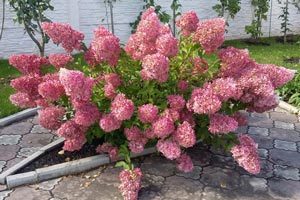 Vanilla Fraz blooms for a long time, practically from the beginning of summer (mid-June) and fades only towards the end of September.
Vanilla Fraz blooms for a long time, practically from the beginning of summer (mid-June) and fades only towards the end of September.
This is, without exaggeration, one of the most beautiful paniculate plants. Its inflorescences resemble an ice cream cone with strawberries and cream. During the flowering period, they are creamy, then they become pale pink, and closer to autumn they acquire a raspberry hue.
Hydrangea of \u200b\u200bthis variety, due to its unpretentiousness and long flowering, is used:
- for private and urban landscaping;
- as part of various landscape compositions;
- in rows of the same type, as a hedge;
- for landscaping parks, gardens, personal plots;
- looks very impressive among lawns.
Good to know: when breeding hydrangea of \u200b\u200bthis variety, its size must be taken into account - the bush can grow up to 2 meters in height and 2 meters in crown diameter in a fairly short period of time.
Growing hydrangea Vanilla Freise

This plant prefers acidic soil or slightly acidic loams (Read on how to acidify the soil). Landing is carried out in the spring in the northern regions and in the spring-autumn period in the southern regions.
The hydrangea of \u200b\u200bthis species has a shallow root system, but it is very branched, so the plant is demanding on moisture and soil fertility.
When planting, one third of a bucket of rotted leafy earth or peat must be poured into each hole. The hole should be approximately 30 centimeters in diameter.
It is not necessary to cover the root base strongly with earth. The distance between the bushes should be about one meter.
Good to know: on the eve of frost, it is good to do mulching with dry sawdust or peat. This will have a beneficial effect on the soil (acidify it) and protect the roots from freezing.
How to care for Vanille Fraise
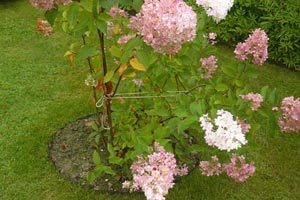
Hydrangea care consists in the timely implementation of all the necessary seasonal activities.
Watering should be abundant and regular. Watering is especially beneficial with rainwater, after which you need to properly loosen the ground under the bush.
Form trimming should be done annually. It is undesirable to allow strong branching of the crown, since the size and number of inflorescences will depend on this. The less the thinning of the branches is, the smaller the peduncles will be, but their number will increase and vice versa.
This hydrangea reacts positively to complex fertilizers. In late spring, it is good to feed with various mineral compositions and diluted slurry. This should be done again in two weeks, which will ensure the best flowering in the current year and a good budding for the next year.
Its frost resistance is up to - 30C!
Good to know: The winter hardiness of Vanilla Freise hydrangea is quite high, so it is not necessary to create shelters for adult plants. But you should protect the bushes from heavy snow, since the branches of the bush are quite fragile and can be easily damaged.
In order for hydrangea to please you with good growth and lush inflorescences, seedlings must be grown in well-moisturized, rich soils. The best will be a combination of humus, leafy soil, sand and peat. This shrub cannot grow in calcareous soils.
If you are growing a Vanille Fraise hydrangea, then you are choosing a green companion for a long period, since the bush can grow and develop up to 40 years or more.
It grows in the south of Sakhalin, in Japan, China. On forest edges, in sparse coppice oak forests.
Hydrangea paniculate small tree up to 10 meters tall with a dense rounded crown, ovoid or elliptical leaves about 12 cm long.
Above, the leaves of hydrangea paniculate are weakly pubescent, from below it is stronger, especially along the veins.
Flowers in long, densely hairy, wide-pyramidal panicles about 25 cm long.
Fertile flowers are very small, their petals are snow-white, early falling, sterile flowers are much larger, up to 2.5 cm in diameter, with four white, then becoming pink petals.
The first flowering is observed at 4 years. The flowers are melliferous. Long bloom - from mid-June to October.
Panicle hydrangea grows quickly, frost-hardy, can withstand temperatures down to -25 degrees, is demanding on soil moisture, gas-resistant.
Abroad varieties are widespread: "Kyushu", "Unique" ("Unique"), "Mathilda", which are characterized not only by large flowers and long flowering, but also by the presence of a pleasant aroma.
Cultivars:
Hydrangea panicle "Grandiflora" ("Grandiflora")
It differs from its species in late flowering and large sterile flowers, collected in wide-pyramidal inflorescences about 30 cm long.
When blooming, the flowers are initially creamy white, in full bloom they are just white, then pink, in autumn they become greenish-red.
![]()
It grows very quickly. Annual growth is about 25 cm. Panicle hydrangea "Grandiflora" is photophilous. Moisture-loving, does not tolerate prolonged drought. In the hot period, it needs watering. Also panicle hydrangea "Grandiflora" is frost-hardy, although in cold winters young plants can freeze over, but winter hardiness increases with age.
Hydrangea paniculata "Brussels Lace"
This hydrangea is distinguished by a huge number of fruiting flowers in the inflorescence and a small number of sterile ones.

It looks much softer than the Floribunda cultivar. In Russia panicle hydrangea "Brussels Lays" is rare.
Hydrangea paniculata Vanilla Fraise
It is one of the most beautiful panicle hydrangeas. The bush is upright, up to 1.5 m in height.

Has large pyramidal inflorescences. The inflorescence of hydrangea paniculata Vanilla Fraze looks like a cone of strawberry ice cream with cream. The flower blooms white, then, the bottom becomes strawberry-red, and the top remains vanilla-white. Hydrangea panicle Vanilla Freise blooms on the shoots of the current year, from July to September.
prefers slightly acidic soil. The landing site should be sunny or partial shade. Very hygrophilous. Frost resistant up to -29 C.
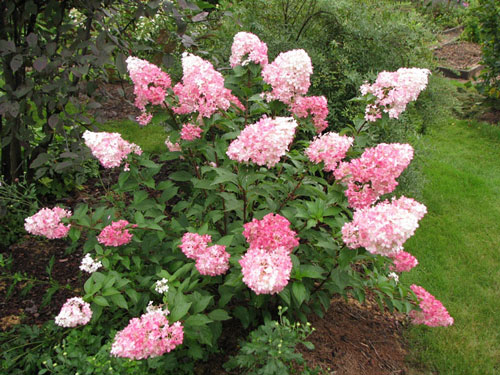
The size and number of inflorescences depends on the pruning. The stronger the pruning, the larger the inflorescences will be, but the number of inflorescences decreases, and vice versa.
Hydrangea paniculata Vanilla Freisov is planted in the northern regions in spring, in the south - in autumn and spring. Plants are planted in early spring at a distance of about a meter from each other, while not deepening the root collar. The size of the pit for young plants should be 30 x 30 x 30 cm.
Have hydrangea paniculata Vanilla Frazthe root system is shallow, but branched. 1/3 of a bucket of peat and humus should be added to each hole, water the plants after planting. It is best to water it with rainwater. After watering, loosen the soil. At the end of May, fertilization should be carried out with mineral fertilizer and a solution of slurry.
Re-fertilization should be applied after 2 weeks. Top dressing ensures the best flowering this year, as well as the laying of flower buds next year. Trunk circles are mulched with peat or humus, after digging, add mulch. In the fall, it is necessary to hilling the bushes to a height of about 20-30 cm.
Hydrangea panicled "Kyushu"
It is characterized by glossy dark green leaves, numerous, not very large inflorescences with a small number of sterile flowers. Shoots protruding, straight, reddish-brown. The leaves of the hydrangea paniculate "Kiushu" are glossy, dark green, and the petioles are red.
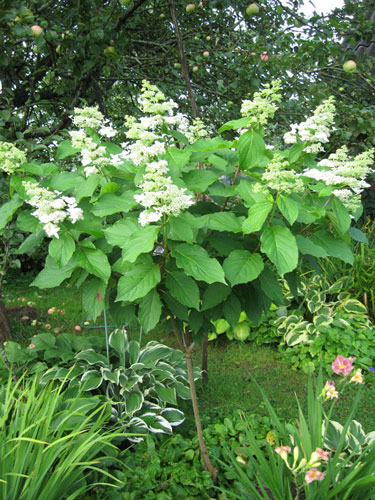
Flowers are white with an amazing aroma, collected in wide and long inflorescences. Bloom from mid-July to September. Photophilous, tolerates partial shade. Hardy, but in cold winters, young plants can freeze over. Moisture-loving.
Hydrangea paniculata "Mathilda"
This shrub is 2 meters high and a crown diameter of about 3 meters. Leaves are dull green, about 7-15 cm long. The crown is round.
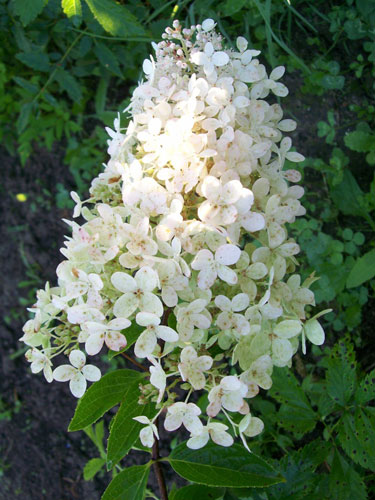
The flowers are large, when blooming they are creamy white, then just white, then turn pink, and when blooming, green-red.
Hydrangea paniculata "Phantom"
This is a shrub whose height is up to 2 m with a spreading crown. The leaves are green, bright. Inflorescences are pyramidal, large, about 30 cm long, consisting of a large number of white flowers with a lilac-pink tint. Hydrangea paniculata "Phantom" blooms from August to October.
![]()
Prefers light, shadow, partial shade. Panicle hydrangea "Phantom" is a very decorative variety.
Hydrangea paniculata "Pink Diamond"
It is a fashionable variety in Europe. Deciduous shrub up to 2 meters in height. Blossoms about 30 cm long consist of sterile and fertile flowers.
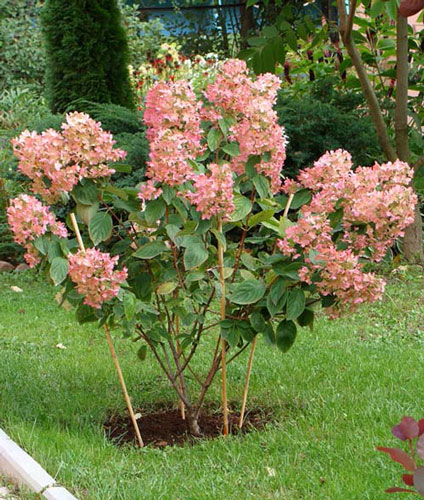
Flowers of hydrangea paniculata "Pink Diamond" when blooming creamy white, then dark pink, almost red.
Hydrangeas paniculata "Pinky Winky"
Characterized by light green leaves, they turn yellow in autumn, pointed, elliptical, with a serrated edge, rough, about 12 cm in length. The flowers are collected in cone-shaped inflorescences 20 cm in length, two-colored - they are white on top, purple-pink below.
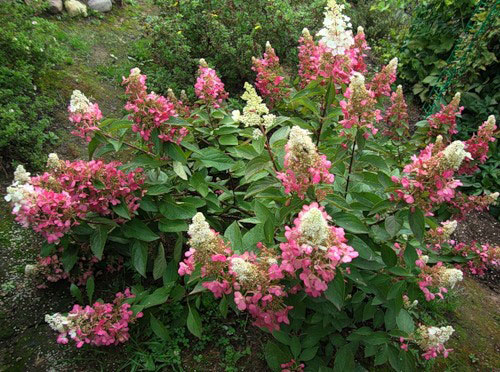
Flowering occurs in July and until September. Hydrangea paniculata Pinky Winky prefers loose, fertile, acidic soils. Photophilous, but tolerates partial shade and does not tolerate drought. Frost resistant.
Hydrangea panicle Bobo ("Bobo")
It is a popular new Belgian hydrangea variety with abundant flowering and short growth. Very decorative. During the flowering of hydrangea paniculate Bobo, the bush is completely buried in huge white caps of luxurious inflorescences. Shoots are vertical.

It begins to bloom in July with large white caps of flowers, which turn pink by autumn. The foliage of the Bobo panicle hydrangea is dark green. Withstands even harsh winters without shelter.
Hydrangea paniculata Diamond Rouge
Shrub about 150 cm high, 120 cm wide. Inflorescences about 30-40 cm in size. Diamond Rouge panicle hydrangea blooms from July to late autumn, the flowers are sterile. First, the flowers are white, then pink, at the end of summer the inflorescences become bright red or even purple-purple in color, which lasts for several weeks.
The bush of hydrangea paniculata Diamond Rouge is compact, dense, strong shoots. In the spring the foliage is green, in the fall it will stop from purple to deep orange.
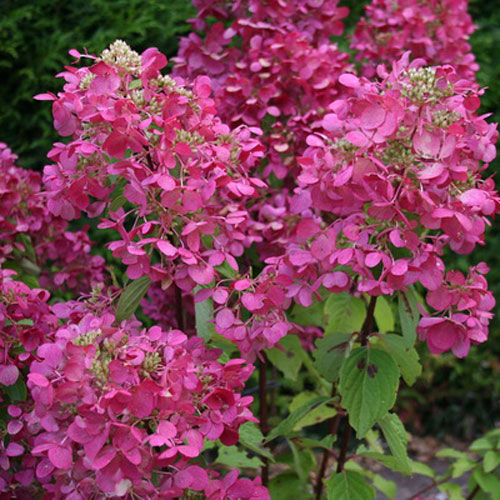
Location
Penumbra, in sunny places, growth slows down, and the inflorescences begin to shrink.
The soil
Fertile soil is needed for abundant flowering. Hydrangea paniculata loves structural clayey soil. For normal life, they need moist soil.

Pruning: For successful flowering, before the beginning of the growing season, the bushes of hydrangea paniculata must be heavily pruned every year. Regular strong spring pruning also promotes long and abundant flowering. If this is not done, then the plant does not develop well and does not even bloom.
Reproduction
Panicle hydrangea reproduces well by cuttings and layering.
Hydrangea paniculata Vanilla freise is considered one of the most beautiful representatives of the paniculata species. It has earned its popularity due to its unpretentiousness, frost resistance and unusually beautiful inflorescences of pink and white shades.
The hydrangea paniculata vanilla fraise cultivar was obtained as a result of painstaking selection work by a French scientist who worked on it for about eleven years.
Hydrangea Vanilla freise grows as a shrub with an asymmetrical crown, the height of which does not exceed two meters. The plant has beautiful oval leaves of a rich green color with a slight roughness. The inflorescences of freesi hydrangea are of the highest decorative value. They are quite large and thick, have a conical shape, so many gardeners compare them to an ice cream cone. This effect is further enhanced by the unique color of the petals. Initially, the flowers dissolve white petals, which gradually acquire a pink hue, which can turn dark crimson by autumn. This gorgeous flowering shrub will delight with its delicate colors from July to September.
Hydrangea vanilla fries is also popular in our region due to its good tolerance to low temperatures. The shrub safely tolerates a drop in air temperature to minus thirty-eight degrees. And if some shoots are slightly frozen, then with the arrival of spring they quickly recover.
Hydrangea of \u200b\u200bthis variety is actively used for landscaping parks, squares, gardens. Shrub forms hedges well, goes well with others garden plants, will give any area a special elegance and as a tapeworm.
But in order for the hydrangea to fully develop and smell sweet, you need to follow the basic rules of its cultivation.
Planting hydrangeas in the garden begins first of all with choosing the right site. The plant loves well-lit spaces, while light partial shade will not hurt it either. It should also be provided that the site has natural protection against strong gusts of wind, which can break fragile shoots.
After choosing a planting site, naturally you need to pay attention to soil preparation. They do this in advance, it is best to prepare the site and planting holes in the fall, and plant the seedlings in the spring. But if this is not possible, then between the preparatory work and direct planting it is necessary to withstand at least two to three weeks.
And so, when preparing the soil, you need to take into account the fact that hydrangeas love acidic soil, and categorically do not accept lime soil. Therefore, the land on the site is fertilized in advance with mineral and organic fertilizers. The next step is soil preparation. For hydrangeas, peat, humus, river sand, turf and leafy soil are mixed in equal proportions, and also before planting, special fertilizers are added to acidify the soil. These can be drugs "Kemira", "Asid plus" and others.
Then the landing pits are prepared, namely:
- pits are dug on the site, the size of which should be at least fifty centimeters in depth and width; in group plantings, they maintain a distance of up to half a meter;
- at the bottom of the planting pit, it is imperative to put a drainage layer about ten centimeters thick from broken brick, small pebbles and river sand;
- the prepared substrate is filled up.
The prepared planting pit should be given time to settle.
The next important point is the choice of a seedling. If planting material is purchased in a store, then preference should be given to trusted sellers. In this case, the seedling must be examined. The stems should be healthy, free from damage and various insects.
And now the planting of the seedling itself. Purchased specimens are most often sold in small containers, so it is best to water the seedling and remove it along with a clod of earth, this will save the roots from damage. Then the hydrangea is placed in a prepared hole and covered with a substrate, while the bush is positioned so that the root collar is flush with the ground. After planting, the plant is abundantly watered and mulched with organic matter (humus, peat).
The further development of hydrangea will depend on proper care for her.
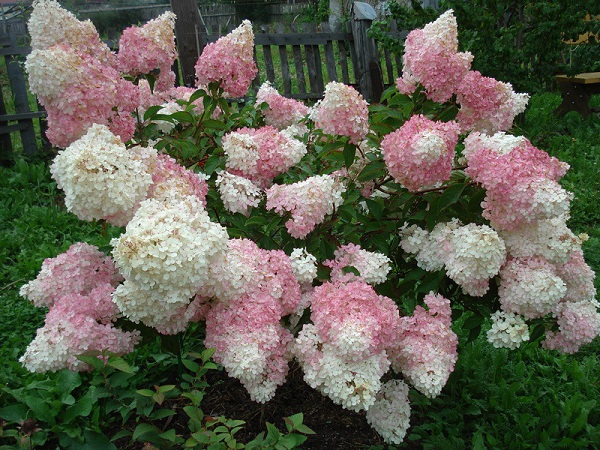
Planting and grooming are the main points that should be given special attention when growing hydrangeas.
Taking care of a flowering shrub is not that difficult. All the plant needs is:
- regular watering;
- top dressing;
- loosening the soil;
- pruning.
The young hydrangea requires the most attention. Her seedlings, planted in open ground this season, require regular watering and periodic renewal of the mulch layer.
An adult bush is also watered abundantly, especially in dry summers and in the absence of rain in the spring. If the spring is rainy, then you should not additionally moisten the soil, since excessiveness can lead to the formation of rot on the roots and the development of fungal diseases.
Water the bush with warm, settled water. The ideal option is rainwater.
It is necessary to periodically loosen the ground around the bushes, this prevents the growth of weeds and promotes oxygen access to the hydrangea root system.
It must be said that adult specimens of Vanilla also need periodic mulching of the root circle. This allows not only to retain moisture in the ground, but also provides the shrub with additional nutrients.
Hydrangea paniculata vanilla frise of the first year of life does not need feeding, since all the necessary compounds were introduced into the soil before planting. But all subsequent years of life, the shrub requires fertilization.
The first top dressing is recommended before the beginning of the growing season, around the beginning of April. The second at the time of bud formation. In the future, I feed the hydrangea twice a month throughout the summer season. Mineral components are used as fertilizers. It is best to use ammonium and potassium nitrate, as well as superphosphate. Fertilization during this period stimulates the formation of a gorgeous crown and abundant and long flowering.
After the hydrangea has faded, it is recommended to renew the mulching layer with organic matter, thereby allowing the plant to receive additional nutrition to prepare for the winter season. Adult specimens do not need shelter in winter, but the seedlings of the first year should be spud and wrapped in burlap.
Pruning hydrangea helps maintain its decorative qualities, allows you to form a beautiful bush, and stimulates abundant flowering. In the fall, after the shrub has faded, all the inflorescences must be removed so that the branches do not break under their weight in winter, although some gardeners leave this procedure for the spring.
In the spring, cut off the shoots. Remove two-thirds of their length. The plant quickly grows new ones and forms flower buds on them.
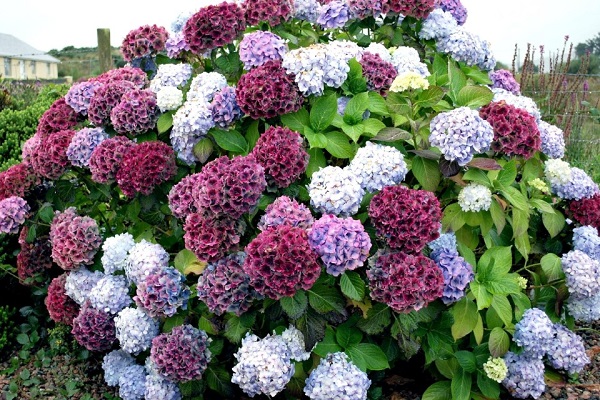
Hydrangea vanilla fraise reproduces in the following ways:
- dividing the bush;
- layering;
- cuttings.
The division of the bush is used for hydrangeas of four to five years of age. It can be carried out in two ways: by completely digging the bush and dividing it into parts, or by undermining and partial separation from the main plant. It must be said that hydrangea is extremely painful to transfer a transplant. Therefore, only a young, but already formed bush with a well-developed root system can be completely excavated and divided. And partial separation is applied to adult shrubs, moreover, such actions contribute to the renewal of the plant.
Reproduction by layering is perhaps the easiest and most harmless way. All you need to do is pick a healthy stem from the bottom of the bush, bend it to the ground, secure it and dig in with nutritious soil. This procedure can be carried out from spring to late summer. By the next season, the cuttings will take root and young shoots will appear on the surface. In the spring, you can safely separate the bush from the adult plant and transplant it to a permanent place, according to the general rules for planting hydrangeas, which are described above.
Cuttings are carried out in early summer. For rooting, young, non-lignified shoots with five nodes are taken and deepened into a previously prepared substrate of earth and sand. The soil must be moist, and completely removed from the cutting lower leaves and the rest are shortened. From above, the planted shoots are covered with glass jars or plastic bottles. Cuttings should be regularly watered and ventilated. When young leaves appear, the shelter is removed. For the winter, the cuttings are covered, and the next spring they are planted in a permanent place.
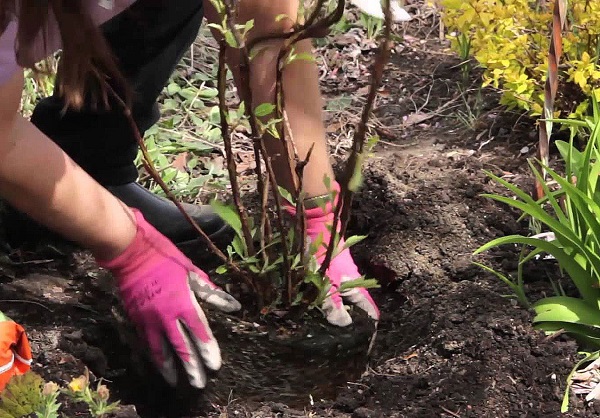
Trouble growing hydrangeas
Vanilla hydrangea has a fairly good immunity. Therefore, it is more rare. But in case of violation of the rules of care and certain conditions environment (high humidity, sharp temperature changes in the summer season) the shrub can be affected by fungal and viral diseases. And if the former can be fought with the help of fungicides and preventive measures are taken, then viral ailments lead to the death of the bush.
Among the most common fungal diseases, powdery mildew can be distinguished. Its appearance is promoted by high humidity at low temperatures in summer. External signs are spots on the leaves with a gray-white powdery bloom that forms over the spores of the fungus. If a disease is detected, the bush should be treated copper sulfate, at least three times with a frequency of ten days.
Hydrangea chlorosis is also common. This is a metabolic disorder in a plant. Treatment is carried out with potassium nitrate and copper sulfate.
Of the insects, green aphids most often attack the bush.
The owners of summer cottages have long been planting not only vegetable beds, but also trying to ennoble their garden with various flowers and ornamental shrubs. One of these representatives of dacha beauty is hydrangea.
This shrub does not grow higher than one and a half meters, and planting and caring for a panicle hydrangea is not difficult and does not entail difficulties. It is because of its unpretentiousness that the hydrangea gained its popularity, that even the choice of beginners is in favor of the presented plant.
Features of the plant and its origin
Panicle hydrangea is the most successful and correct option for self-planting in a summer cottage. In height, as already mentioned above, the bush does not even reach one and a half meters, but its flowers will envelop all the branches.
During the flowering period, the shrub envelops spherical inflorescences with sizes of 25-30 cm.In diameter, one flower grows on average to 2-3 cm.
The panicle hydrangea today includes several dozen varieties, although even during the Soviet era there were no more than 5 of them.
The presented fact is primarily associated with high-tech developments, or, simply put, with the hybridization process, thanks to which today you can enjoy inflorescences of a wide variety of shades.
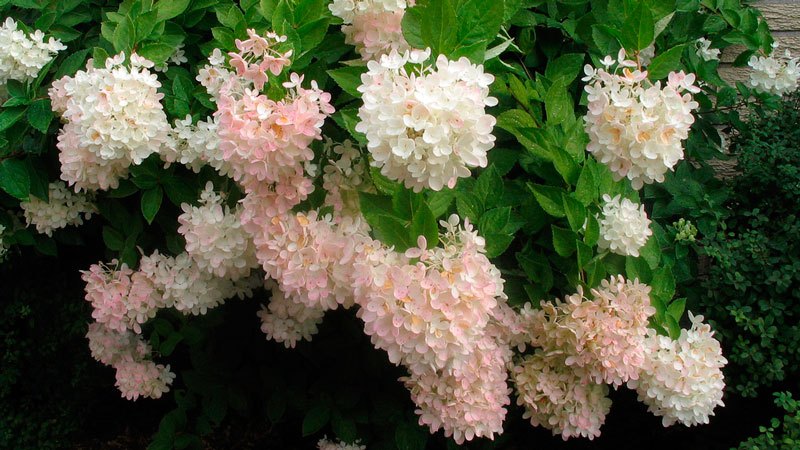
Hydrangea came to summer cottages from the Far East, where the shrub went through a period of "domestication" after wild life in China and Japan. By the way, now you can still find wild-growing hydrangeas in these countries, however, their growth does not even reach 1 meter.
Appearance garden varieties the presented shrub allows you to use it in summer cottages in landscape design, since, if desired, the bush can be given a suitable shape with the help of timely pruning.
Varieties of panicle hydrangea with photo
Varieties of hydrangea paniculata can be listed for a long time. In the last year, several more varieties of newly bred representatives have appeared, which are not yet used by gardeners on a grand scale. Of the most widely known, the following varieties are given:
Hydrangea Bobo - the most popular, was bred by Belgian biologists. Its height reaches a maximum of 70 cm, which makes it especially popular, because in this case it is much easier to highlight on garden plot landing place. This variety belongs to the early representatives - the flowers begin to bloom and turn pink in May. The appearance of the bush is quite dense with a rich green color. 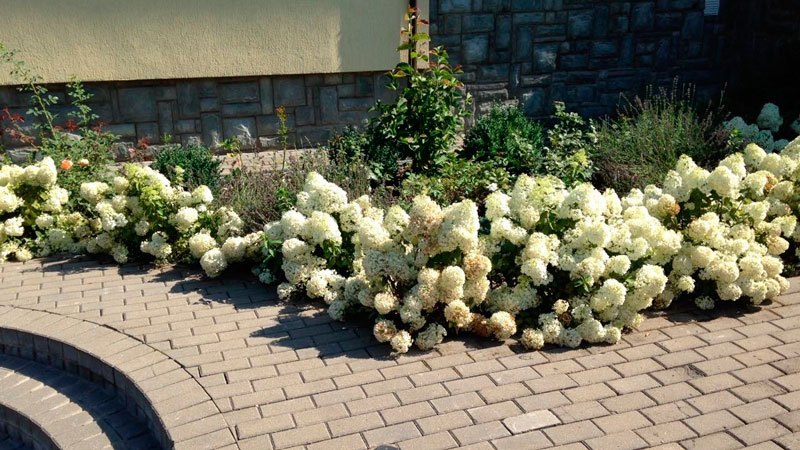
- the shrub reaches a height of one and a half meters, but this does not take away the well-deserved popularity of the plant. Experienced growers are delighted with the density of the pyramidal inflorescences. In addition, the inflorescences always acquire two colors - the top is painted with a white shade, and the bottom becomes pale pink. As a result appearance more like an ice cream cone. ![]()
- a tall shrub, at least one and a half meters high. The variety has gained popularity due to its flower color. In the process of flowering, the shade of the inflorescences changes from white to bright red, burgundy. In addition, this variety is frost-resistant, therefore it is suitable for planting in any region of Russia. True, in Siberia and on Far East additional cover for the bushes will be required for the winter. 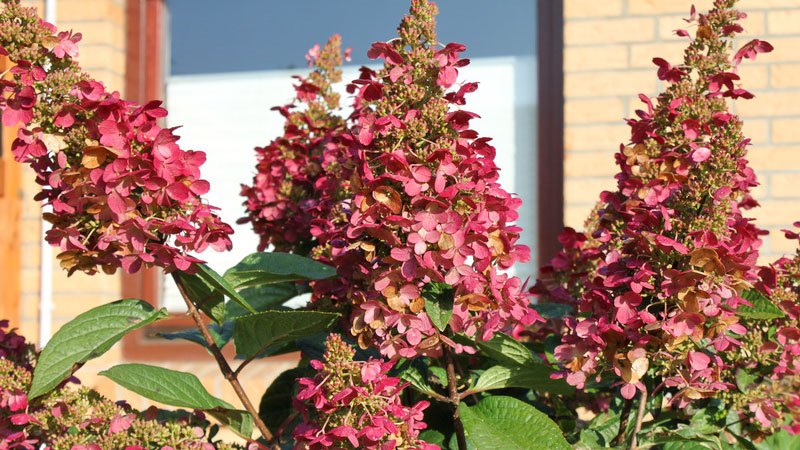
Hydrangea paniculata Grandiflora - refers to late varieties, which is actively used for planting in summer cottages in warm regions. Hydrangea Grandiflora changes the shade of its inflorescence several times. At the very beginning of flowering, the flowers are creamy white, and then become just white. At the end of the season you can admire the cone-shaped inflorescence of red-green color.
- shrub variety grows up to one and a half meters in height. Shades of flowers turn from white to pale pink, and the foliage itself with the onset of autumn turns from a rich green hue to orange. 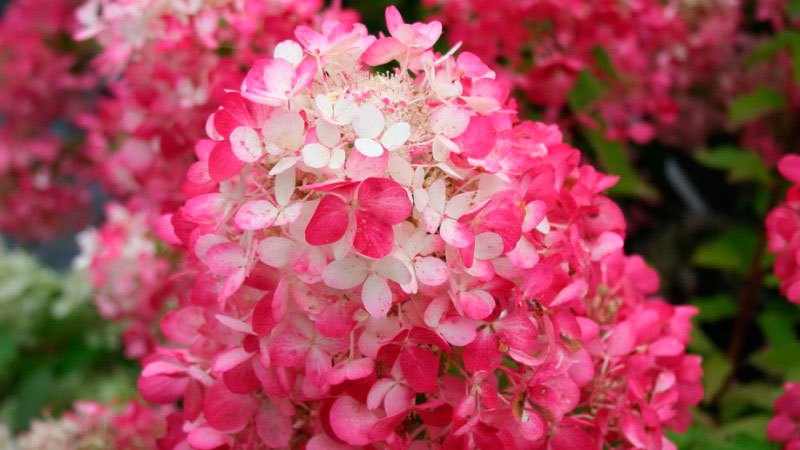
Hydrangea Lightline - a new variety that was bred by American scientists and went on sale only in 2014. According to the creators, the height of the grown shrub does not exceed one meter. The popularity of the presented variety is still small, but the beauty of the inflorescences delights.
- the flowering time of the variety is from mid-July to September. The cone-shaped inflorescences are colored in two shades - the top is white and the bottom is purple. The inflorescences themselves are not so dense, so you can see the beauty of each flower. The leaves acquire a rich yellow tint in the fall. 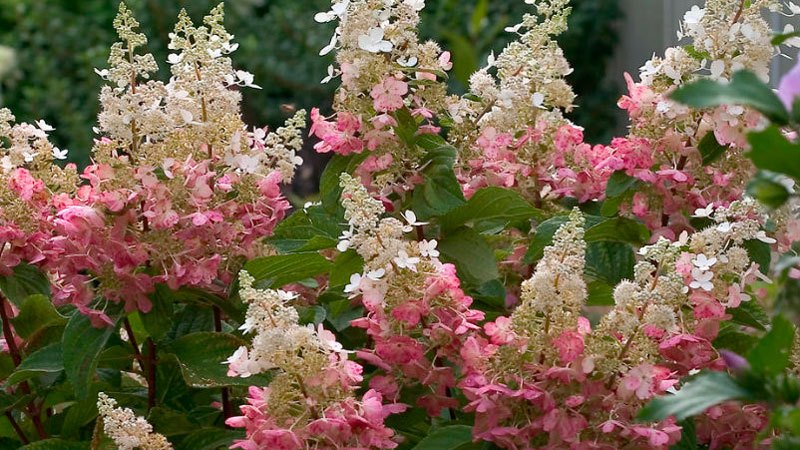
- the popularity of this variety was won in Europe due to the height of the shrub. The average length of a hydrangea is 2 meters. In Russia, these representatives are also planted, but mainly in large areas. 
- notable for its spreading crown, which is rather difficult to "collect" into a bush and give the necessary shape. However, this variety is also popular in Russia, because its inflorescences tend to change color from pale green to pink. 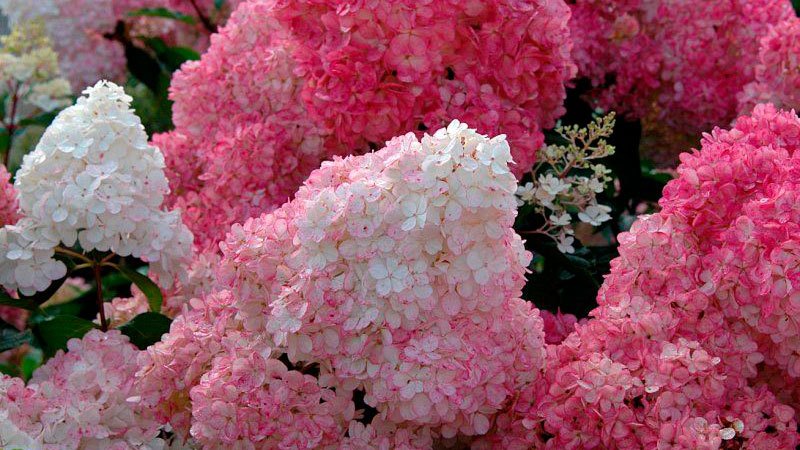
- a sprawling bush with a maximum height of one and a half meters. Conical inflorescences of a pale yellow shade. During the flowering process, the yellow color is completely lost and turns into a pure white color. 
Hydrangea paniculata Phantom - the variety belongs to the late representatives, because its flowering is observed only from mid-August to early October. The height of the presented shrub reaches about 2 meters. The crown of the hydrangea is spreading, and the flowers are white with a delicate lilac tint.
This is just a small list of all the varieties available. Some representatives have not even "reached" the Russian gardeners yet, since they have just been bred and are only being tested in planting in their own country.
Varieties of hydrangea paniculata, video:
Planting and caring for panicle hydrangea
Despite the wide selection of varieties of the presented ornamental shrub, the basics and principles of planting and caring for a plant are practically the same.
The actions described in the following are easy to cope with and a beginner who has just decided to refine and decorate his summer cottage.
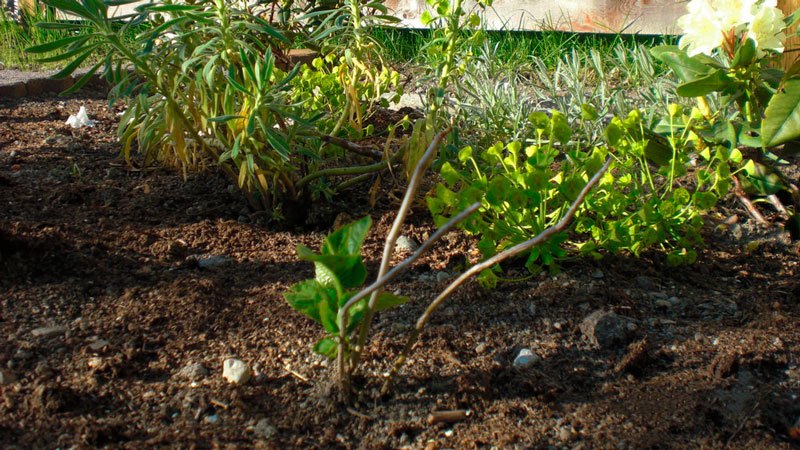
Correct planting of hydrangea paniculata
At the initial stage, you should decide on the choice of time for planting the shrub. This process can be carried out both in spring and autumn.
It is better, of course, to plant a seedling in the spring. In the summer, he will get used to it faster, he will have more chances to settle down in the climatic conditions provided to him.
Planting hydrangea paniculata in autumn will require the gardener to take additional steps to cover the seedling for the winter. This process must be carried out without fail, even if the planted variety turns out to be frost-resistant.
Now you need to decide on the choice of location. Most of the varieties prefer partial shade. However, such a planting is fraught with a partial "loss" of beauty during flowering. So, planting in a sunny area, but with protection from the wind, will provide full and abundant flowering and bud dissolution.
Such abundant watering is carried out once a week. During rainy times, the frequency or volume of fluid should be reduced.
Gardeners have one important rule to follow when watering: the soil under the ornamental shrub must always be moist.
To achieve the appropriate moisture content within a week, you can resort to mulching the soil with sawdust. In the water intended for irrigation, you can add not a large number of potassium permanganate. In this case, the water should achieve a slightly pink hue.

2. Top dressing is carried out for the entire flowering period 4 times:
- The first feeding is carried out in the spring at the stage of inflorescence formation. It is better to use organic fertilizers such as slurry.
- The second feeding is carried out already during the ripening of the buds. It uses various formulations containing urea, superphosphates and potassium.
- In the third top dressing, a mineral fertilizer complex is used. The time for complementary foods depends on the degree of flowering of the shrub. Take a closer look, if all the buds have blossomed, then you can start the procedure. Such actions will significantly increase the flowering time of the hydrangea.
- During the preparation of the bush for the winter period, a fourth feeding should be carried out. Here, it is better to use special chemical compositions for hydrangeas, which are easy to purchase in a specialized store.
All the actions presented will ensure normal growth and timely flowering of the ornamental bush, which means they will delight gardeners throughout the summer period.
3. Pruning hydrangea paniculata is carried out as needed in order to give the plant the correct and neat shape during the period of growth and flowering.
But often it is required pruning hydrangea paniculata in autumn while preparing the plant for winter.
If the answer to the question of how to prune a panicle hydrangea in the fall is clear, then most novice gardeners remain confused, not imagining the pruning procedure for forming a bush.
In the spring, determine 5-10 strong shoots on each bush. Cut them to length so that only 3-5 buds remain. Thus, the nutrient components will contribute to the growth and strengthening of only young shoots, which means that the bush during flowering will delight with new and bright inflorescences.
only the root system.
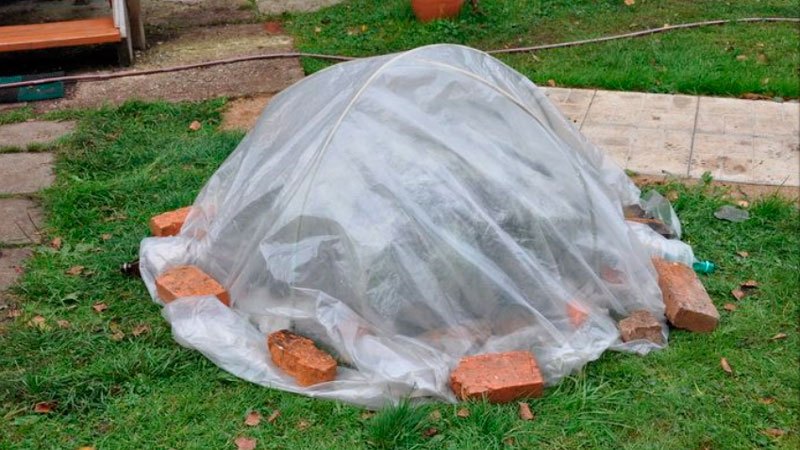
Shelter is carried out in the following ways:
- Use rotted manure. Spread it in a small layer around the bush.
- You can use peat or fallen leaves. But then the covering layer will need at least 15-20 cm.
- If you fear the frost resistance of the branches, build a frame around the shrub, which will trap snow on itself and thereby create a kind of greenhouse for hydrangea.
Additional steps in preparing the bush for the winter are not required. It is only important to carry out timely pruning and shelter, without waiting for severe frosts.
As for the propagation of paniculata hydrangea, there is a method of cuttings.
The trimmed parts of the branches should be placed in water for three days, and then a cutting with at least 3 internodes should be made from them. The lower cut of the cuttings made is treated with a growth stimulant and planted at home in pots to a depth of 2/3.
It is better to grow cuttings in regular indoor pots until next spring. In the warm season, you can safely plant the grown bushes in your summer cottage.
Panicle hydrangea does not require complex and long-term care. But all of the above actions will ensure excellent flowering throughout the entire period for the variety.
There are quite a few varieties of hydrangeas - tree-like, paniculate, large-leaved, oak-leaved, petiolate, serrate. My hobby is panicle hydrangea. One of my favorite varieties is Vanilla Fraise (Hydrangea paniculata Vanille Fraise).
I saw a photo of her in a magazine and was simply fascinated by her. It was difficult to buy this variety in free sale in Russia then. But i searched hard, phoned friends, looked through ads in magazines. If you really want something, you will definitely get it. Soon, I met a family of Muscovites who are engaged in the cultivation of hydrangeas. It was they who gave me three cuttings of the desired variety.
Rooting cuttings at home
Imagine how i literally "flew" home, clutching the precious twigs. At home, the first thing I did was prepare a solution of a root formation stimulator (5 drops of Zircon dripped in 100 ml of water) and put the cuttings in it for a couple of hours. Each of them had 3 pairs of leaves. I removed the bottom leaves, cut the rest in half.
I poured the soil mixture into the pots (peat + fine sand + a little humus + agroperlite), moistened well and carefully planted the cuttings in them under a slight slope. The soil around the cuttings has compacted a little. I put each pot in a bag, tied the bag. Periodically ventilated and, if necessary, moistened the soil. When young shoots began to grow on the cuttings, I slowly began to accustom them to the surrounding air. First, I opened the bags for 10 minutes, then for 20, and so on. Soon and completely took them off.

I plant young bushes in the garden
When the roots of the young plants were well wrapped around a clod of earth in pots, I planted them in the garden. For the variety "Vanilla Fries" it is necessary to choose a place so that in the morning and after lunch the bush is well lit, and a shadow falls on it during the day.
Planting soil prepared from a mixture of peat, sand, garden soil, old humus. To acidify the soil, I added a bag (30 g) of colloidal sulfur to it. You can take potassium sulfate instead of sulfur (200 g per one planting pit with a diameter of 50 cm).
It is necessary to plant a rooted stalk no deeper than it sits in a pot. After planting, spill well with water.
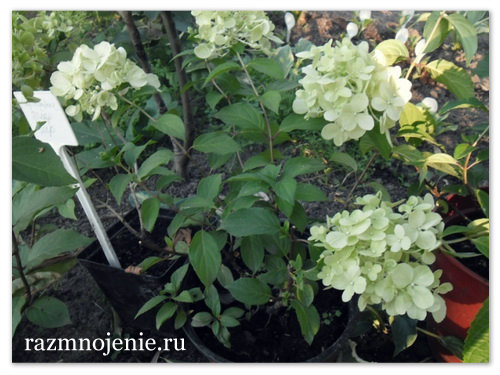
Should I cover her?
The first winter I covered young plants - I put a box over them, on it - a non-woven material, put a film on top, pressing it along the edges. In subsequent years, it did not cover the bushes, since this variety is quite frost-hardy.
How I take care of my darling
Hydrangea care is not difficult. In the spring I feed it with any nitrogen fertilizer (more often nitrate or potash), in the summer - with fermented grass or a special fertilizer for hydrangeas (you can take fertilizer for azaleas and rhododendrons). Closer to autumn I add superphosphate.
Do not apply under hydrangeas (any) ash, dolomite flour or lime, they alkalize the soil, and these shrubs require increased soil acidity. Top dressing is needed for lush flowering in the summer and the laying of new flower buds in the fall.
Hydrangeas love to drink (hydrangea from the word "water"). To prevent the earth from drying out, I mulch the surface around the bushes with peat or well-rotted sawdust with a layer of 8-10 cm.
So that my hydrangeas develop well and bloom, every month in the summer I spill the soil under them with acidified water. I add 1 teaspoon with a heap of citric acid or 100 ml of 9% vinegar to a ten-liter bucket of water. This should be done regularly.

Pruning
In order for the panicle hydrangea to bloom in large inflorescences, pruning of the shoots is necessary.
Until the age of four, I do not touch the bush, let it grow. I always prune hydrangeas over four years old. In the fall, I remove the faded inflorescences, shorten the young growth, leaving 4 buds each. In the spring, I cut out the frozen, old, weak and growing shoots inside the bush. You should not often cut paniculate hydrangeas too much, as they are able to form many shoots and, as a result, thicken strongly.
Reproduction of panicle hydrangea
I use the cuttings left over from pruning for rooting. If there are many cuttings, it is better to root them in the cuttings.
I made mine simply. In partial shade (a shadow falls on him at midday), she dug up the earth, mixed it with sand, peat, agroperlite (by eye), added a little humus, poured a layer of fine sand on top, spilled the garden bed well. I put low arcs, stretched a non-woven material over them (it was also moistened), on top - a film.
I keep the non-woven fabric constantly wet to increase the moisture in the cuttings. If the sun hits the garden during the day, I shade it from 12 to 16 hours. Sprinkle the edges of the film with earth to maintain moisture inside the greenhouse. From time to time I open the film and look at the cuttings, if necessary, moisten the soil.
After the formation of a good bunch of roots, the cuttings are transplanted into pots or on a bed for growing.
it quick way get a large number of young bushes. There are other methods of reproduction - by layering, seeds, but I do not use them, therefore I will not describe.
Autumn charm
When I first saw the Vanilla Fries bloom in autumn, I was simply fascinated and shocked.
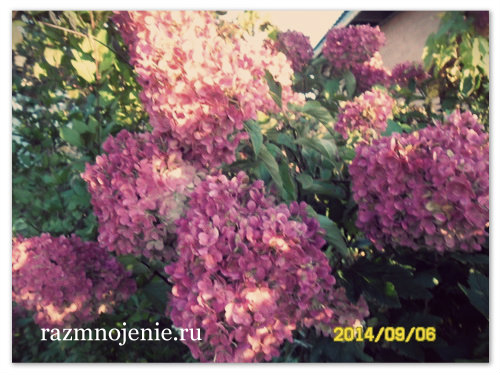
Imagine high, about 2 meters, a bush with huge inflorescences, colored rather unusually. Below the flowers are crimson, then the color smoothly turns into pink and the crown is white. No wonder the name “Vanilla Fries” is translated as “vanilla-strawberry”. They also say - like "strawberries with cream". I must say that it blooms with white inflorescences in July. Gradually, as the flowers ripen, they change their color to pink, then to raspberry-burgundy, starting from the bottom of the inflorescence.
The size of the inflorescence of an adult "Vanilla Fries" is impressive - its length is about 40 cm, width - about 30 cm!
Want to decorate your site? Purchase a Vanilla Frize hydrangea. With its flowering, it will delight you for many years.
Pestova Olga Alekseevna, Rzhev,
experienced amateur florist
and owner of a small outdoor plant nursery



